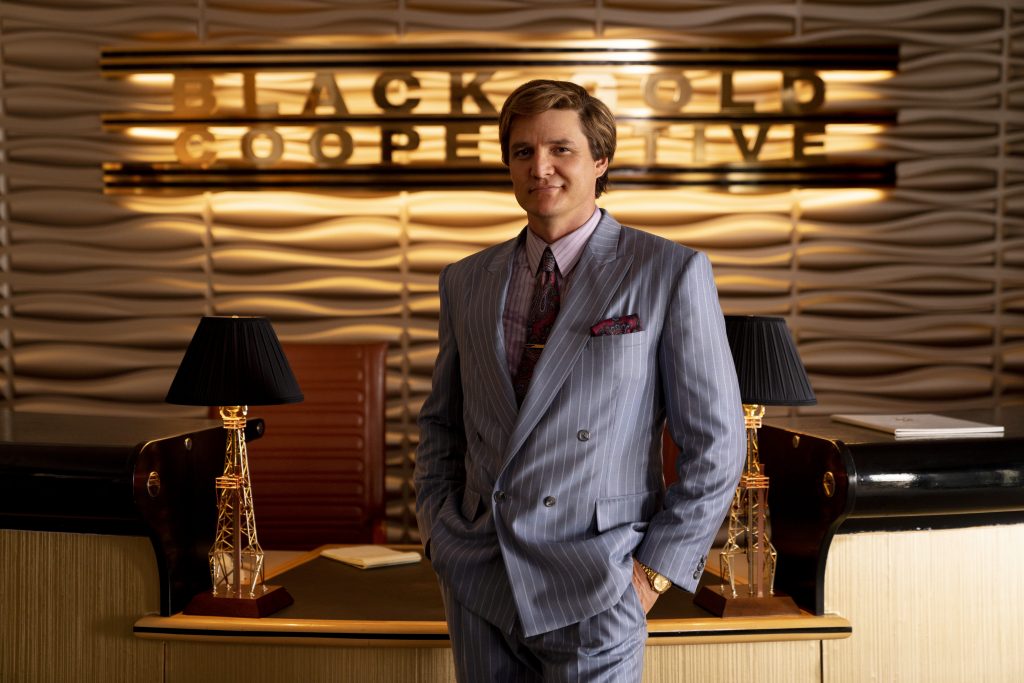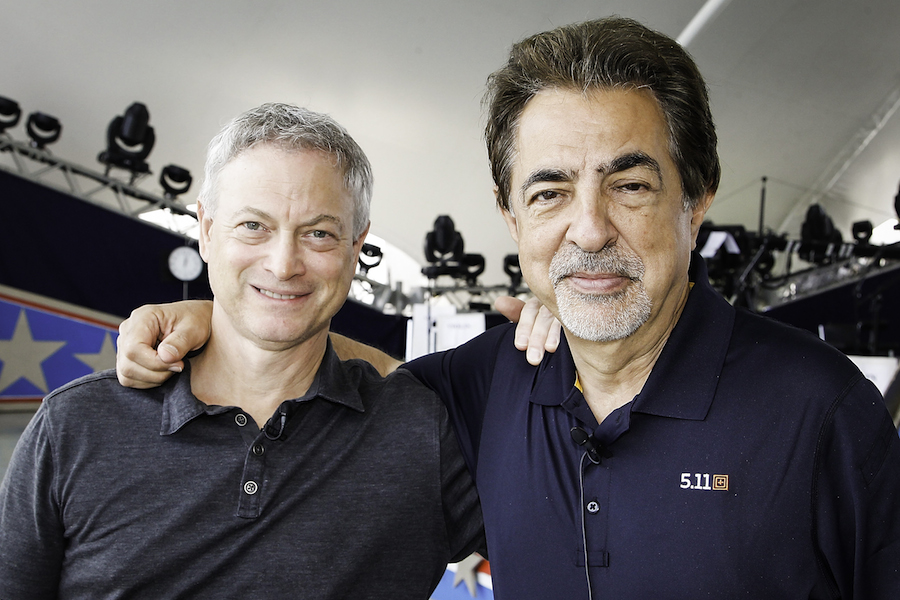December 4, 2021
by Carla Hay

Directed by Denzel Washington
Culture Representation: Taking place from 1998 to 2018, in New York City; Akron, Ohio; Washington, D.C.; and Iraq, the dramatic film “A Journal for Jordan” has a racially diverse cast of characters (African American and white people, with a few Asians and Latinos) representing the working-class and middle-class.
Culture Clash: Based on true events, a single mother to a 12-year-old son tells the story of her relationship with her son’s deceased father, who was a U.S. Army sergeant killed in the line of duty in Iraq.
Culture Audience: “A Journal for Jordan” will appeal primarily to people who are fans of star Michael B. Jordan, director Denzel Washington (who does not appear in the movie) and emotion-driven stories about love and loss.

“A Journal for Jordan” pulls at audience heartstrings in all the right ways by telling this romantic and bittersweet story that ultimately celebrates life and what we make of it. Directed by Denzel Washington and written by Virgil Williams, the dramatic film “A Journal for Jordan” is based on journalist/book publisher Dana Canedy’s 2008 memoir of the same name. The book not only told Canedy’s story but also the story of her fiancé Charles Monroe King, a U.S. Army sergeant who was killed in the line of duty in Iraq in 2006, less than two months before he had been scheduled to return to the United States. The book included King’s journal entries that he wrote to his and Canedy’s son Jordan, who was a baby when King died.
“A Journal for Jordan,” which is Washington’s fourth feature film as a director, is his most sentimental and heartwearming movie that he’s helmed so far. It’s also the first movie that Oscar-winning actor Washington has directed where he is not in the movie as an actor. Although the movie’s title might give the impression that Jordan (played by Jalon Christian) is the focus of the story, he is not.
The story (which jumps around in the timeline) is centered on Jordan’s parents Dana (played by Chanté Adams) and Charles (played by Michael B. Jordan) and what happened during their eight-year romance. The other parts of the movie show Dana’s life as a single mother raising Jordan. Washington and Jordan are two of the producers of “A Journal for Jordan.”
A movie like this could be overly sappy, but director Washington shows admirable restraint in letting the story unfold tenderly—mostly in flashbacks that have the tone of fond memories through the lens of longing for someone who has passed away. Even the film’s musical score (by Marcelo Zarvos) is understated. There are no bombastic, violin-heavy orchestrations to manipulate people’s emotions, as is often the case with movies about tragic love stories.
“A Journal for Jordan” opens with a fever-dream type of montage that’s a collage of memories of Charles and Dana as lovers, as well as scenes of the Iraq combat zone where Charles tragically lost his life. If people see this movie without knowing what the story is about beforehand, it’s clear in the first five minutes that someone has died. The movie doesn’t take long to tell audiences who it is.
The movie’s first scene of dialogue takes place in New York City in 2007. Dana is a senior editor at The New York Times, where she’s an intelligent, hard-working and ambitious employee who does investigative news work. She’s just landed an interview with an important source for a story she’s been working on of her own initiative.
When she tells her boss (played by Stephen Sherman) that she got this crucial interview, she’s dismayed to find out that he’s assigned a co-worker named Rosenblum (played by Spencer Squire) to work with her on the story, based on Rosenblum saying (but not proving) that he could have valuable information to add. Dana isn’t happy about someone being added to a story that she worked hard on from the beginning. And she says so to her boss, who basically cuts her off and ignores her concerns, as he walks side-by-side with Rosenblum in front of her.
When the boss turns around to talk to Dana, he has a look of slight disgust on his face as he indicates to Dana that she should look at her blouse. Dana looks down at her blouse and is embarrassed to see there’s a stain from leakage of breast milk. It’s a moment that nursing mothers can dread because they know that there are sexist bosses and co-workers who think that pregnancy and childbirth make women less competent employees.
Viewers who’ve worked in newsrooms will also notice how realistic this scene is in showing the subtle but still noticeable ways in which people who aren’t white men are often treated with less respect in work environments that give white men the biggest leadership positions and the highest salaries. The scene also shows that Dana is the type of person who’s not afraid to speak up for herself, even if she doesn’t get the results that she deserves. In other words, Dana is no pushover.
As a frustrated Dana goes back to her office, she gripes to a middle-aged co-worker named Miriam (played by Susan Pourfar), who is Jordan’s godmother, about Rosenblum being dropped in on her assignment, probably because she knows that Rosenblum will get credit for a lot of the work that Dana did. Miriam is sympathetic, but she seems worried about how Dana is living. “Don’t isolate yourself,” Miriam tells Dana.
Miriam thinks Dana’s life should be about more than just going to work and going home. Dana reminds Miriam that she’s a single mother of a baby and doesn’t have time for much of a personal life. At home, Dana seems lonely and somewhat overwhelmed—not about taking care of the baby but by grief over the loss of Jordan’s father.
And sure enough, Charles appears to her in a dream, as a somewhat shadowy figure where he says, “Tell him everything, Ma.” (Ma was his nickname for Dana after she became a mother.) And the next thing you know, Dana is on her computer, typing out her memories of Charles for Jordan to read when he gets old enough to understand.
During her writing, Dana also includes quotes that Charles wrote in his “A Father’s Legacy” journal. Some of the quotes include: “Dear Jordan, I want you to know that it’s okay for boys to cry” because “crying can release a lot of pain and stress. It has nothing to do with your manhood.” This trip down memory lane triggers the flashbacks that are shown in the movie.
The majority of the movie then shows the ups and downs of the relationship between Charles and Dana, beginning when they met in 1998. Charles was a first sergeant in the U.S. Army stationed in Ohio. At this point in his life, Charles has been in the Army for 11 years. He grew close to Dana’s retired parents (played by Robert Wisdom and Tamara Tunie), who live in Akron, Ohio. Charles’ parents aren’t seen in the movie, but soon after he meets Dana, he tells Dana that he loves his parents, but he couldn’t get through certain things in life without the family-like support of Dana’s parents.
Dana’s parents treat Charles almost like a son. How this surrogate family relationship developed is not shown in the movie, which is told from Dana’s perspective. Dana’s strict father used to be a drill sergeant in the U.S. Army. Charles met Dana’s father through some kind of Army connection. After Dana meets Charles, she finds out that he’s so close to her father, that Charles calls him Pop. Charles tells Dana it’s because her parents have helped him with a lot of emotional support. She replies sarcastically, “You didn’t grow up with them.”
Dana tries to avoid visiting her parents as much as possible. It’s not that she doesn’t love them, but seeing her parents brings back painful memories of her childhood and reminds her of the type of life that she doesn’t want to have. It’s revealed in bits in pieces of conversations in the movie that Dana thinks that her parents have an unhappy marriage and that it’s her father’s fault because he has a long history of infidelity. Dana saw firsthand how this infidelity made her mother miserable but afraid to end the marriage. It’s why Dana has major issues with trust and commitment when it comes to romantic relationships.
In the spring of 1998, Dana goes back home to visit her family, which also includes her younger bachelorette sister Gwen and her younger married brother Mike. As an indication of how much distance she wants to keep from her parents, Dana stays in a hotel instead of her parents’ house during this visit. During a sibling conversation in their parents’ backyard (where Gwen calls Dana a “Type A” personality), Dana makes no apologies for her big-city, single life. “Men are luxuries, not necessities,” Dana comments.
Dana meets Charles when she stops by his place at the recommendation of her father, who clearly wants to play matchmaker. Charles is an illustrator artist in his spare time. (He likes to do portraits of people.) Dana admires his work and asks him who his favorite artists are. He says Claude Monet and Georges Seurat.
Dana, who considers herself to be a sophisticated intellectual, is immediately impressed. Charles also says that his life goal is to retire from the Army when he reaches the title of sergeant major, and then he wants to devote his time to painting art. After finding out about his love of art, Dana gives Charles an obvious chance to visit her in New York. She tells Charles that maybe he’d like to see a real Monet painting up close at the Metropolitan Museum of Art.
There’s an immediate attraction between Dana and Charles, but she plays it cool overall, at first. Because Charles knows that Dana is staying at a hotel, Charles asks Dana if he can drive her to the Canedy family barbecue happening the next day. She agrees and is a little taken aback when he suggests that he pick her up at 9 a.m., which is hours before the barbecue starts.
Dana says yes, but she oversleeps and isn’t ready when Charles arrives to pick her up at scheduled 9 a.m. time. She’s very apologetic, he’s very understanding, and they head to a local diner to have breakfast. It all sounds like the beginnings of an ideal romance. But there are a few obstacles, as there are always seems to be in real-life love stories that are made into movies.
For starters, Charles tells Dana that he’s in the middle of a divorce. His estranged wife, who lives in Texas, has custody of their daughter Christina. (Christina is never seen in the movie.) Charles tells Dana that his marriage fell apart because he and his soon-to-be-ex-wife were too young when they got married, but he says that he loves being a father. Dana is accepting of this information, but she’s thinking at this point that Charles isn’t likely to become her boyfriend because they would have to do long-distance dating.
Things go well at the barbecue. Charles is polite, respectful and attentive to Dana. And, of course, family members happily notice that Dana seems to like Charles as much as he seems to like her. However, the realities of Charles’ divorce and single parenthood come crashing in on Charles and Dana’s first date when he leaves the barbecue early because he says he has a phone date to talk with Christina.
Another slight bump in the road comes when it takes nearly two months for Charles to call Dana again after their first date together. She’s slightly annoyed that it took him this long, but he explains that he waited until his divorce was made final. Dana likes Charles enough to give him a chance to get to know her better.
Dana and Charles end up dating, of course, and their romance kicks into high gear when he visits her many times in New York. On the first visit, she invites him to stay with her at her apartment. First, she says he can sleep on the couch. Then, she changes her mind and says he can sleep in the same bed with her.
Their courtship is sweet and passionate. Charles is not as sophisticated as Dana initially thought he was, but she doesn’t mind. For example, when he first visits her in New York, they go to an Italian restaurant for a dinner date. It’s there that Dana finds out that Charles doesn’t know what olive oil is because he asks her what it is when it’s put on the table. Dana also has to educate Charles on the differences between shows that are Broadway, off-Broadway and off-off-Broadway.
In addition, Dana thinks Charles could have a better sense of fashion. She notices that he likes to wear jeans and scruffy-looking athletic shoes. No problem. She buys him a designer suit as her first Christmas gift to him. He’s a little uncomfortable with wearing suits, but he knows that if he’s going to be in Dana’s life and the types of social events that she goes to, there’ll come a time when he’ll have to wear a fancy suit. And so, Charles accepts the gift when Dana goes with him in the store to see if the suit fits.
Charles also likes to tell corny jokes. Dana doesn’t mind that either. She thinks it’s actually a little endearing. For example, one of his running jokes is saying, “Guess what?” And then following it up by saying, “Chicken butt.” These are some of the little jokes that couples have that make Charles and Dana’s romance realistic and relatable to people who’ve had similar relationships. Meanwhile, Dana’s career at The New York Times is thriving, and she eventually gets promoted to senior editor.
It’s not all smoth sailing though for Charles and Dana’s relationship. Charles’ Army career means that he has to move around a lot. There are also instances where Dana gets upset because she thinks that Charles seems to care more about his Army colleagues than he cares about her, while he thinks she’s not understanding enough about his military responsibilities. These disagreements about his Army commitments cause the biggest conflicts in their relationship. After 9/11 happens and Charles is deployed to Iraq, the relationship gets put even more to the test.
“A Journal for Jordan” can be a little too slow-paced for some viewers, but the movie remains thoroughly grounded in reality. The fact of the matter is that in real life, a lot of romances go in stops and starts. People who want to see a movie with a lot of melodramatic contrivances found in too many romantic dramas will be disappointed. There’s no love triangle, no meddling best friend, no race to the airport to tell someone they want to make the relationship work. People who are tired of seeing these over-used clichés in romantic movies will be delighted that “A Journal for Jordan” can’t be bothered with these clichés.
What audiences will get is an authentic look at a romance between emotionally mature and responsible adults. Adams gives a charming and engaging performance that exudes all the real qualities that strong, independent women have when they allow themselves to be open and vulnerable to love. Jordan is equally charismatic in his own way in portraying this Army sergeant with a strong moral compass, a deep sense of loyalty and a romantic side that many people look for in a partner.
Charles is not a flashy Romeo but someone who says and does what exactly what he means. And that’s so much more important than “big talkers” who make grandiose promises that they have no intention of keeping. Charles and Dana aren’t perfect, but when they make mistakes or hurt each other emotionally, they try to make things right. And they accept each other for who they are. That’s true love.
“A Journal for Jordan” is a refreshing example of a movie that shows what a lot of middle-class African Americans are really like. It’s become tiresome to see African American romances depicted in movies and TV shows as relationships plagued by crime, poverty or drugs. The reality is that many African Americans are a lot like Charles and Dana, so kudos to everyone involved who helped make this true story into a movie.
“A Journal for Jordan” is also about another type of love story that’s just as important, even though it doesn’t get as much screen time in the movie: the love between a parent and a child. The scenes of Jordan as a 12-year-old have a deep emotional impact because it’s when he starts to become very curious about his father. Jordan’s questions bring up heartbreaking memories for Dana, who has been reluctant to tell Jordan the details of how Charles died.
Even though most of the movie is about the mostly happy romance between Dana and Charles, make no mistake: There are several scenes in the movie that are intended to be tearjerkers. Two of these scenes involve a bunch of red balloons that Charles had with him on a day that he and Dana were spending some time outdoors with Jordan. Another emotionally charged sequence happens during a trip that Dana and 12-year-old Jordan take to Washington, D.C.
The pace might drag a little in some areas of “A Journal for Jordan,” but if you care about these characters and what happens to them, then the movie is watchable from beginning to end. You don’t have to come from a military family to relate to what happens in the movie. Anyone who has treasured memories of a loved one can relate to this true story, which has been eloquently expressed in this inspirational film.
Columbia Pictures will release “A Journal for Jordan” in U.S. cinemas on December 25, 2021.








